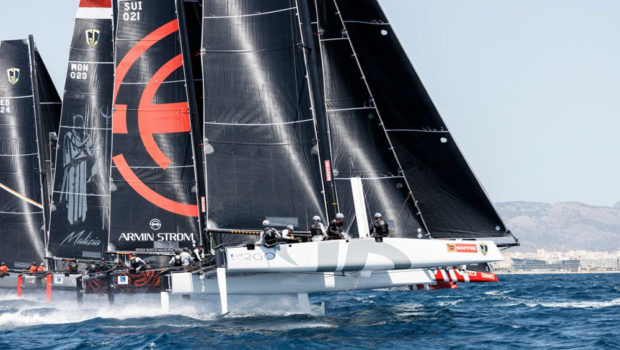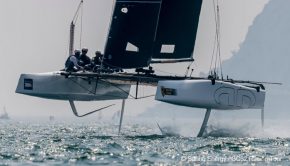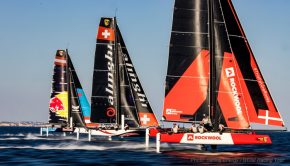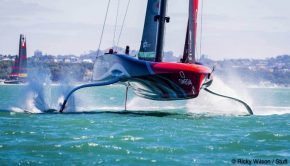Playing the Speed Game
Published on September 7th, 2016
The GC32 Racing Tour in Europe provides a scaled down version of the format used for the America’s Cup World Series. US Virgin Island sailor Anthony Kotoun, who sails aboard the only American GC32 – Jason Carroll’s Argo Racing – shares with Sail Racing Magazine what life on foils is like…
It will come as no surprise that with the America’s Cup-style reaching starts you can do yourself a lot of favours by winning that first reach. If you can get out in front, it’s like fresh powder downhill skiing, but if you get stuck back in the peloton you can get really blocked.
That first reach is pretty hectic. My job is grind the mainsheet so I’m looking up wind and I’m trying to call the puffs and our speed relation to anybody that’s starting above us. I’d be lying if I didn’t admit that I’m definitely always keeping a wary eye to my left in case somebody in front of us plugs it. If that happens you just have to get low and hang on.
For sure though it’s a very exhilarating part of the race. You can’t believe you’re doing it sometimes and that all the teams are getting along that well on the reach. It’s very, very, very fast.
Like in all racing your decisions are not often dictated by yourself but by the action of others around you. So we talk a lot about ways of breaking free if you do get stuck in the peloton.
The tactics and strategy of that reach are straightforward: if you start high, generally you have a better angle, but you’re sailing more distance. If it’s lighter, then usually you have a better angle from the leeward end of the line and there’s the added advantage that you’re on the inside when you reach the turn. Usually though the race committee knows this and they offset the top of the starting line or the reach buoy position so that there’s always some strategy to it.
In terms of starting technique it seems like there’s definitely two thoughts. One way is to line up and edge closer and closer to the start line in the final minute, before you pull the trigger to pop up on the foils at the gun.
Then there’s what in America we would call a “Vanderbilt Start”. This obviously originates from way back in the day and is where you come blasting through from behind at 20 knots while everybody on the front row is static in that couple of seconds before they have got up on their foils. Often there’s not enough real estate behind the line for that so it can be a bit of a risky option.
After the reach it’s windward-leeward legs, so once you are off and running – like always in sail racing – it’s all about sailing fast and clean and avoiding huge boat-handling mistakes.
The point is that, although a lot of people are afraid that the move to foiling in events like ours and the America’s Cup has meant a turn away from tactics and strategy, they couldn’t be more wrong – there’s tons of tactics and strategy, it’s just different to what we were used to.









 We’ll keep your information safe.
We’ll keep your information safe.